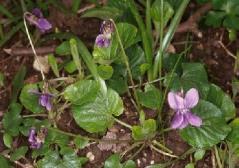
Viola odorata / البنفسج
Sweet Violet
Banafsaj, Albanafsaj alhelou
Background
- Evergreen perennial ornamental plant, of the Violet family (Violaceae).
- Found wild in many regions of the world, e.g. South and eastern Africa, South America, France, Italy, Australia and New Zealand.
- Cultivated all over the world as an ornamental plant.
Part(s) Used
Whole plant, leaves, roots and flowers
Traditional and Medicinal Uses
Sweet violet has a strong folk reputation in the treatment of cancer and whooping cough. It also contains salicylic acid, which is used to make aspirin, and is therefore effective in the treatment of headaches, migraine and insomnia. The leaves are edible and can also be cooked. It has been used as/for:
|
Expectorant |
Diaphoretic |
Cough |
Perfumery |
|
Asthma |
Abdominal pain |
Anxiety |
Menopausal symptoms |
|
Bronchitis |
Gastritis |
Insomnia |
Allergic rhinitis |
How Much Do We Know?
Sweet violet was found to contain saponins, alkaloids, glycosides, anthocyanins, tannins, beta-sitosterol, methyl salicylate, cycloviolacin, vitamin C, flavonoids, linalool, alpha-cadinol, globulol, and viridiflorol.
What Do We Know About Safety?
- Likely safe when used orally in food amounts.
- Sweet violet essential oil and extracts are considered generally recognized as safe (GRAS) by the FDA for use as a food additive.
- Possibly safe when used intranasally for short-term.
Using Sweet violet by
Mouth
sweet violet has been used as one cup of tea 2-3 times daily; by steeping 2 teaspoons of the herb in 250 mL boiling water for 10-15 minutes.
Intranasal
for allergic rhinitis, Sweet violet flower oil in almond oil has been used as 1 drop placed in each nostril every 12 hours for 2 weeks.
Special Precautions & Warnings
Pregnancy, Breast-feeding
Insufficient reliable information available; avoid using.
Children
Possibly safe when used orally and appropriately.
Keep in Mind
- Do not hesitate to speak with your health care provider before starting to use any supplements.
- Discuss potential benefits and risks, especially if you are suffering from any health problems.
